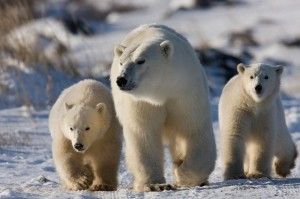
Polar Bear with Cubs in Churchill, Manitoba – Michael Poliza Photo
Life often deals winning and losing hands at the same time – and it all depends who gets the Aces. This year, it’s the polar bears of the Eastern Arctic and Western Hudson Bay who are winning, with the longest, coldest spring in decades. This follows last year’s “normal” spring, with ice persisting on Hudson Bay until mid- August.
Over the past 40 years, scientific knowledge of the ecology of western Hudson Bay has expanded at a tremendous rate. The famous white bears of Churchill were familiar to anyone who lived in the area for as long as anyone’s notes or memory extends. In fact, due to the exceptional interests of several of the traders working for the Hudson Bay Company, Churchill is credited with having the oldest and most accurate birding records of any location in the world! Weather and climate data, and observations of many other natural features were also accurately recorded for almost 400 years. Largely missing from this body of data were scientifically verified details about the intimate lives of the bears and birds – how and when they reproduced, how many offspring they had, growth rates, physiological details etc. That type of knowledge began to rapidly accumulate in the 1960s and ‘70s, with the change in Churchill’s economic focus from trading, shipping and military towards research and ecotourism.
In a nutshell, key points from what was learned about the birds and the bears included the fact that the birds arrive in a rush in the spring (that’s late April and May, not July!). They arrive carrying fat stores and developing eggs in their bodies – essential because the weather does not usually allow them to put on weight when they arrive – everything is still emerging from the grip of winter. Some of the birds nest near Churchill, but the majority will only pass through – heading for the food-rich predator-limited conditions offered by the burst of life in the Arctic summer.
For the polar bears, spring is also a critical time of year. Unlike the other bears most of us are familiar with, which pack on weight in late summer and autumn before their winter’s sleep, the polar bears’ boom time is spring – from April to July – when the young seals are born. These young seals grow at tremendous rates (their bodies may be 50% fat) and are very available to the bears because of their inexperience. The bears slowly lose weight throughout the remainder of the year, so the right conditions in springtime are essential.
Keeping the key points above in mind, it’s easy to understand why 2009 has winners and losers. The birds are trapped by the weather, food is limited and they use up their fat stores. They absorb their growing eggs or lay their eggs only to have them freeze. And finally they head south again without nesting.
On the other hand, the polar bears bask in the cool spring conditions, feeding on seals for a month or more – longer than average. The end result is large numbers of fat and healthy polar bears, with numerous healthy cubs – and great bear watching seasons in 2009 and 2010!








